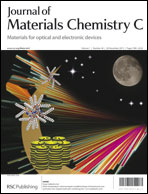Bipolar host materials for high efficiency phosphorescent organic light emitting diodes: tuning the HOMO/LUMO levels without reducing the triplet energy in a linear system†
Abstract
Two novel bipolar host materials, BCzSCN and BCzSPO, consisting of an electron deficient cyano or diphenylphosphine oxide acceptor linked to a bicarbazole donor, were designed and synthesized. Their thermal, photophysical and electrochemical properties were systematically investigated. Both BCzSCN and BCzSPO show high triplet energies of over 2.75 eV and could be developed for application in blue phosphorescent organic light-emitting diodes (PHOLEDs), and further for white PHOLEDs. Moreover, the characterization of hole-only and electron-only devices based on BCzSCN and BCzSPO indicate their rather balanced hole/electron injection and transport properties. Blue PHOLEDs containing BCzSCN and BCzSPO as the hosts and FIrpic as a dopant exhibited excellent performance, with maximum external quantum efficiencies of 19.3% and 17.1% respectively. In particular, blue PHOLEDs adopting BCzSCN and BCzSPO exhibited extraordinary low efficiency roll-offs of 5.2% and 7.6% at a brightness of 1000 cd m−2, respectively. Meanwhile, the all-phosphor near-white devices hosted by the two materials were also fabricated, and high external quantum efficiencies of 22.0% and 21.3% were achieved.


 Please wait while we load your content...
Please wait while we load your content...